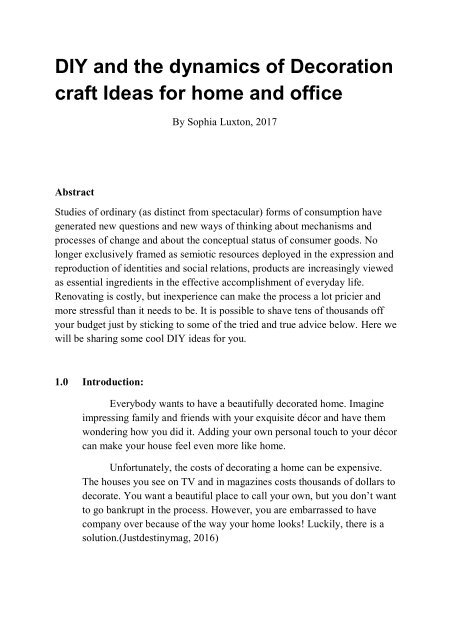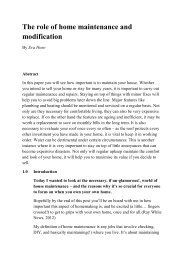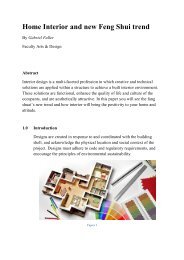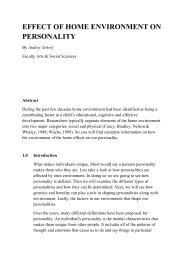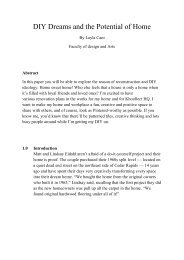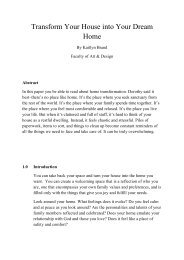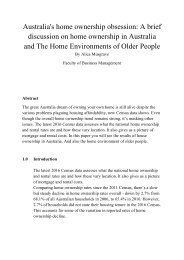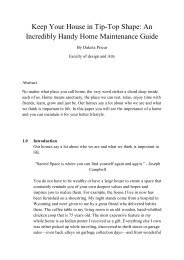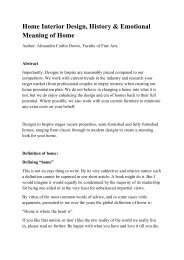DIY and the dynamics of Decoration craft Ideas for home and office
You also want an ePaper? Increase the reach of your titles
YUMPU automatically turns print PDFs into web optimized ePapers that Google loves.
<strong>DIY</strong> <strong>and</strong> <strong>the</strong> <strong>dynamics</strong> <strong>of</strong> <strong>Decoration</strong><br />
<strong>craft</strong> <strong>Ideas</strong> <strong>for</strong> <strong>home</strong> <strong>and</strong> <strong>of</strong>fice<br />
By Sophia Luxton, 2017<br />
Abstract<br />
Studies <strong>of</strong> ordinary (as distinct from spectacular) <strong>for</strong>ms <strong>of</strong> consumption have<br />
generated new questions <strong>and</strong> new ways <strong>of</strong> thinking about mechanisms <strong>and</strong><br />
processes <strong>of</strong> change <strong>and</strong> about <strong>the</strong> conceptual status <strong>of</strong> consumer goods. No<br />
longer exclusively framed as semiotic resources deployed in <strong>the</strong> expression <strong>and</strong><br />
reproduction <strong>of</strong> identities <strong>and</strong> social relations, products are increasingly viewed<br />
as essential ingredients in <strong>the</strong> effective accomplishment <strong>of</strong> everyday life.<br />
Renovating is costly, but inexperience can make <strong>the</strong> process a lot pricier <strong>and</strong><br />
more stressful than it needs to be. It is possible to shave tens <strong>of</strong> thous<strong>and</strong>s <strong>of</strong>f<br />
your budget just by sticking to some <strong>of</strong> <strong>the</strong> tried <strong>and</strong> true advice below. Here we<br />
will be sharing some cool <strong>DIY</strong> ideas <strong>for</strong> you.<br />
1.0 Introduction:<br />
Everybody wants to have a beautifully decorated <strong>home</strong>. Imagine<br />
impressing family <strong>and</strong> friends with your exquisite décor <strong>and</strong> have <strong>the</strong>m<br />
wondering how you did it. Adding your own personal touch to your décor<br />
can make your house feel even more like <strong>home</strong>.<br />
Un<strong>for</strong>tunately, <strong>the</strong> costs <strong>of</strong> decorating a <strong>home</strong> can be expensive.<br />
The houses you see on TV <strong>and</strong> in magazines costs thous<strong>and</strong>s <strong>of</strong> dollars to<br />
decorate. You want a beautiful place to call your own, but you don‘t want<br />
to go bankrupt in <strong>the</strong> process. However, you are embarrassed to have<br />
company over because <strong>of</strong> <strong>the</strong> way your <strong>home</strong> looks! Luckily, <strong>the</strong>re is a<br />
solution.(Justdestinymag, 2016)
Figure 1<br />
We have ga<strong>the</strong>red <strong>the</strong> 18 best <strong>DIY</strong> <strong>home</strong> decor projects <strong>and</strong> put<br />
<strong>the</strong>m into this simple lists. These projects are easy, af<strong>for</strong>dable, <strong>and</strong> most<br />
importantly look fantastic. These projects will make <strong>the</strong> most<br />
inexperienced <strong>home</strong> decorator into an expert, or make an expert look<br />
even more creative. You have been thinking about adding some new flair<br />
to your <strong>home</strong> <strong>for</strong> years.<br />
With <strong>the</strong>se af<strong>for</strong>dable projects you now have no excuse. Save your<br />
money <strong>for</strong> more important things, <strong>and</strong> decorate your <strong>home</strong> beautifully on<br />
a budget!(Eva, 2016)<br />
2.0 What is <strong>DIY</strong>:<br />
Do-it-yourself is a broad term that can enclose everything from<br />
<strong>home</strong> renovations to <strong>craft</strong>s. Here, <strong>DIY</strong> refers to a subculture encouraging<br />
<strong>the</strong> idea <strong>of</strong> personal projects <strong>and</strong> creations, particularly focusing on <strong>craft</strong>s,<br />
fashion <strong>and</strong> self-publishing.(Vienneau, 2011)<br />
Until <strong>the</strong> development <strong>of</strong> dedicated <strong>DIY</strong> stores in <strong>the</strong> 1970s, people<br />
who wanted to decorate, repair or modify <strong>the</strong>ir own <strong>home</strong> had to venture<br />
into <strong>the</strong> specialised world <strong>of</strong> <strong>the</strong> traditional builders‘ merchant (Roush<br />
1999). The very idea <strong>of</strong> <strong>DIY</strong> was undoubtedly promoted by companies<br />
making <strong>and</strong> selling tools <strong>and</strong> materials to amateur ra<strong>the</strong>r than pr<strong>of</strong>essional<br />
customers.
Although power tools were widely used in <strong>the</strong> building trade long<br />
be<strong>for</strong>e, <strong>the</strong>y did not find <strong>the</strong>ir way into <strong>the</strong> domestic market on any scale<br />
until <strong>the</strong> mid-twentieth century. In recent years <strong>the</strong> range available to <strong>the</strong><br />
<strong>home</strong> <strong>DIY</strong>er has exp<strong>and</strong>ed dramatically. At <strong>the</strong> same time, prices –<br />
especially <strong>of</strong> basic items like <strong>the</strong> ‗entry level‘ power drill have dropped<br />
spectacularly. Although <strong>the</strong> general trend remains one in which<br />
pr<strong>of</strong>essional models are adapted <strong>for</strong> less dem<strong>and</strong>ing domestic use, some<br />
power tools have been substantially re-designed from <strong>the</strong> bottom up with<br />
<strong>the</strong> amateur consumer explicitly in mind (see, <strong>for</strong> example, Black <strong>and</strong><br />
Decker‘s multi-functional ‗Quattro‘ or B&Q‘s ergonomic <strong>and</strong><br />
zoomorphic ‗S<strong>and</strong>bug‘).<br />
Innovations in materials like fibreboard (MDF), in plastic<br />
(plumbing) <strong>and</strong> in fixing technology (especially glues) have since<br />
extended <strong>the</strong> range <strong>of</strong> tasks <strong>the</strong> average h<strong>and</strong>yperson is willing <strong>and</strong> able<br />
to take on. New product ranges <strong>and</strong> methods <strong>of</strong> retailing have helped<br />
establish <strong>DIY</strong> as something that ordinary people might do, but as we<br />
indicate below, sources <strong>of</strong> consumer competence <strong>and</strong> confidence are also<br />
critical. Woodwork, sometimes metalwork <strong>and</strong> more recently, <strong>craft</strong>,<br />
design <strong>and</strong> technology have figured on UK school curricula – at least <strong>for</strong><br />
boys – since <strong>the</strong> nineteenth century. Schools continue to teach children<br />
how to h<strong>and</strong>le materials <strong>and</strong> tools <strong>and</strong> have equipped at least some <strong>of</strong><br />
<strong>the</strong>m with <strong>the</strong> confidence to tackle <strong>DIY</strong> projects <strong>and</strong> to use power tools at<br />
<strong>home</strong>. Home improvement <strong>and</strong> makeover shows on day time <strong>and</strong> prime<br />
time TV fur<strong>the</strong>r rein<strong>for</strong>ce <strong>the</strong> idea that properties can be customised <strong>and</strong><br />
values enhanced <strong>and</strong> that renovation is both normal <strong>and</strong> legitimate.<br />
Our industry respondents were not convinced that <strong>the</strong>se<br />
programmes transmit meaningful knowledge or impart <strong>the</strong> skills required<br />
to do <strong>the</strong> jobs <strong>the</strong>y represent. Even so, <strong>the</strong>y are impressively effective in<br />
inspiring householders <strong>and</strong> giving <strong>the</strong>m <strong>the</strong> (possibly misplaced)<br />
confidence to embark on relatively ambitious projects. Besides <strong>the</strong>se<br />
more or less institutionalised channels, our own research demonstrates<br />
that personal networks <strong>of</strong> family, friends <strong>and</strong> neighbours are crucial <strong>for</strong><br />
individual experiences <strong>of</strong> <strong>DIY</strong> <strong>and</strong> so, cumulatively, <strong>for</strong> its development<br />
as a recognised area <strong>of</strong> social practice.<br />
Being inspired by what <strong>the</strong> neighbours have done, depending on a<br />
friend to provide an extra pair <strong>of</strong> h<strong>and</strong>s, or being able to phone a
knowledgeable parent when things get stuck featured prominently in our<br />
respondents‘accounts, all <strong>of</strong> which suggest that <strong>DIY</strong> would be much less<br />
widespread if it really meant doing jobs entirely alone. These separate<br />
influences (manufacturers, retailers, media, family <strong>and</strong> friends) have<br />
arguably combined to make <strong>DIY</strong> what it is today. Around 62% <strong>of</strong> <strong>the</strong> UK<br />
adult population now claim to participate in <strong>DIY</strong>, including decorating a<br />
separate category defined as ―internal <strong>and</strong> external painting, staining or<br />
wallpapering‖ (Mintel 2003; 2005).<br />
Their motives <strong>for</strong> doing so undoubtedly vary, some seeing it as a<br />
<strong>for</strong>m <strong>of</strong> work o<strong>the</strong>rs as an arena <strong>for</strong> self-expression <strong>and</strong> creativity; some<br />
being driven by economic considerations, o<strong>the</strong>rs by notions <strong>of</strong> quality,<br />
care <strong>and</strong> control. According to Mintel‘s consumer research (2005) over<br />
25% <strong>of</strong> UK adults enjoy <strong>DIY</strong> <strong>and</strong> 8% go so far as to identify it as a<br />
hobby. These figures raise interesting questions about what makes <strong>DIY</strong><br />
rewarding - is it <strong>the</strong> process itself, <strong>the</strong> exercise <strong>of</strong> existing competence,<br />
<strong>the</strong> challenge <strong>of</strong> learning new skills or <strong>the</strong> satisfaction <strong>of</strong> <strong>the</strong> result?<br />
2.1: Practices <strong>and</strong> Projects:<br />
Respondents used <strong>the</strong> notion <strong>of</strong> ‗a project‘ frequently <strong>and</strong><br />
fluidly. Putting up a shelf counted as a project <strong>and</strong> so did knocking down<br />
a wall. In talking about his attic renovation, Will referred to moving <strong>the</strong><br />
radiator as ‗a project‘, even though this task was but one step in <strong>the</strong> larger<br />
scheme <strong>of</strong> creating a space in which <strong>the</strong> children could play. For <strong>the</strong> most<br />
part, people used <strong>the</strong> term to describe planned, temporally bounded<br />
episodes or sequences <strong>of</strong> activity resulting in an observable outcome.<br />
What counted as a project varied widely yet <strong>the</strong> notion was uni<strong>for</strong>mly<br />
important as a way <strong>of</strong> structuring <strong>the</strong> o<strong>the</strong>rwise boundless flow <strong>of</strong> daily<br />
life (Zerubavel 1985). Time was set aside <strong>for</strong> projects, tools <strong>and</strong> materials<br />
were acquired or assembled with <strong>the</strong> project in mind, <strong>and</strong> projects were<br />
<strong>the</strong> basic building blocks <strong>of</strong> individual <strong>DIY</strong> careers. Used in <strong>the</strong>se ways,<br />
<strong>the</strong> project st<strong>and</strong>s somewhat outside <strong>the</strong> streams <strong>of</strong> practice <strong>and</strong> <strong>the</strong><br />
momentary conjunctions <strong>of</strong> tools <strong>and</strong> skills that characterise <strong>the</strong> doing <strong>of</strong><br />
<strong>DIY</strong>. (Watson & Shove, 2008)<br />
3.0 <strong>DIY</strong> Cultures: HISTORIC OVERVIEW
One <strong>of</strong> <strong>the</strong> earliest ―modern era‖ <strong>DIY</strong> communities <strong>for</strong>med among<br />
amateur radio hobbyists in <strong>the</strong> 1920‘s (Figure 1). These hobbyists relied<br />
on amateur h<strong>and</strong>books, which stressed ―imagination <strong>and</strong> an open mind‖<br />
nearly as much as <strong>the</strong> technical aspects <strong>of</strong> radio communication. Ham<br />
radio enthusiasts <strong>of</strong>ten met in person to discuss <strong>the</strong>ir work as well as<br />
unrelated social subjects.<br />
Figure 2<br />
They continued to thrive rebelliously during World War II, when a<br />
ban was placed on amateur radio communication. Rebellious attitudes<br />
continued to pervade pirate radio stations <strong>of</strong> <strong>the</strong> 1960‘s <strong>and</strong> h<strong>and</strong>made<br />
‗zines‘ expressing <strong>the</strong> punk aes<strong>the</strong>tic in <strong>the</strong> 1970s‘ (Figure 1). Later in <strong>the</strong><br />
1980‘s, low-cost MIDI equipment enabled people without <strong>for</strong>mal training<br />
to record electronic music, evolving into <strong>the</strong> rave culture <strong>of</strong> <strong>the</strong> 1990‘s<br />
[26]. During this time, computer hobbyists also <strong>for</strong>med communities to<br />
create, explore <strong>and</strong> exploit s<strong>of</strong>tware systems, resulting in <strong>the</strong> Hacker<br />
culture.<br />
Today‘s <strong>DIY</strong> cultures reflect <strong>the</strong> anticonsumerism, rebelliousness,<br />
<strong>and</strong> creativity <strong>of</strong> earlier <strong>DIY</strong> initiatives, supporting <strong>the</strong> ideology that<br />
people can create ra<strong>the</strong>r than buy <strong>the</strong> things <strong>the</strong>y want.
Figure 3<br />
4.0 Modern <strong>DIY</strong> Communities:<br />
Recent breakthroughs in technology af<strong>for</strong>d sharing such that<br />
anyone can quickly document <strong>and</strong> showcase <strong>the</strong>ir <strong>DIY</strong> projects to a large<br />
audience. An emerging body <strong>of</strong> tools allows enthusiasts to collaboratively<br />
critique, brainstorm <strong>and</strong> troubleshoot <strong>the</strong>ir work, <strong>of</strong>ten in real-time [e.g.<br />
1,11,32]. This accessibility <strong>and</strong> decentralization has enabled large<br />
communities to <strong>for</strong>m around <strong>the</strong> transfer <strong>of</strong> <strong>DIY</strong> in<strong>for</strong>mation, attracting<br />
individuals who are curious, passionate <strong>and</strong>/or heavily involved in <strong>DIY</strong><br />
work. Thous<strong>and</strong>s <strong>of</strong> <strong>DIY</strong> communities exist today, varying in size,<br />
organization <strong>and</strong> project structure. Some allow members to contribute<br />
asynchronously on a variety <strong>of</strong> topics, while o<strong>the</strong>rs focus on specific<br />
projects such as knitting, crocheting or hip <strong>craft</strong>. Some revolve around<br />
smaller in-person ga<strong>the</strong>rings <strong>and</strong> some enable hobbyists to trade or sell<br />
<strong>the</strong>ir projects. (Kuznetsov & Paulos, 2010)
5.0 Where is <strong>the</strong> modern interior?<br />
The special role played by <strong>the</strong> HDB's notions <strong>of</strong> domestic interior<br />
in <strong>the</strong> modernisation <strong>of</strong> post-independence Singapore echoes <strong>the</strong> central<br />
place <strong>the</strong> interior held in early <strong>the</strong>orisations <strong>of</strong> modernity more generally.<br />
For example, Benjamin (1999) saw <strong>the</strong> ornamented 19th-century<br />
domestic interior as an emblematic space <strong>of</strong> modernity, against which <strong>the</strong><br />
ideals <strong>and</strong> aes<strong>the</strong>tics <strong>of</strong> modernism <strong>for</strong>med.<br />
In what follows we take as a starting point Benjamin's reflections<br />
on <strong>the</strong> relationship between <strong>the</strong> domestic interior, modernity, <strong>and</strong><br />
modernism. In doing so we do not wish to imply that a modernity<br />
(including architectural modernism) that originated in Europe was simply<br />
applied to, or poorly imitated in, Singapore. To do so would be to entrap<br />
Singaporean modernisation <strong>and</strong> modernism within a developmentalist<br />
model (Robinson, 2006). But we do not wish to dislodge modernism<br />
entirely from <strong>the</strong> specificities <strong>of</strong> its production such that its `international'<br />
aspirations outrank <strong>the</strong> situated nature <strong>of</strong> its making (<strong>and</strong> remaking).<br />
The stylistic <strong>and</strong> ideological shape <strong>of</strong> <strong>the</strong> modernism in which<br />
Singapore invested in so enthusiastically through its housing programme<br />
was, in <strong>the</strong> first instance, generated in Europe (although see Vogt, 1998).<br />
The post-independence Singaporean interior, although made <strong>and</strong> lived<br />
within <strong>the</strong> context <strong>of</strong> quite localised agendas <strong>and</strong> aspirations <strong>and</strong>, as we<br />
shall see, reshaping modernism quite dramatically, was at <strong>the</strong> same time<br />
inevitably in conversation with this o<strong>the</strong>r history <strong>and</strong> geography.<br />
This framework <strong>for</strong> delivering design principles placed everyday<br />
interpretations <strong>and</strong> innovations centre stage <strong>of</strong> <strong>the</strong> HDB's interior design<br />
story, such that modernist design principles were drawn into more<br />
ordinary interiors shaped not only by design ideals, but also by <strong>the</strong><br />
pragmatic limits set by residents' budgets, <strong>DIY</strong> abilities, <strong>and</strong> existing<br />
furniture. Following are <strong>the</strong> element <strong>for</strong> interior <strong>DIY</strong>:<br />
Colour<br />
Use <strong>of</strong> colour was an important part <strong>of</strong> <strong>the</strong> advice<br />
given to residents through <strong>the</strong> de¨cor articles in Our<br />
Home. Considering <strong>the</strong> indebtedness <strong>of</strong> <strong>the</strong> highrise to<br />
modernist design principles, it is unsurprising that<br />
much advice was about <strong>the</strong> dangers <strong>of</strong> heavy colour''
<strong>and</strong> <strong>the</strong> practical ``sense'' <strong>of</strong> using lighter colours,<br />
especially white (1978, pages 21 <strong>and</strong> 24). As we noted<br />
above, within modernism whiteness operated to reveal<br />
<strong>the</strong> true function <strong>of</strong> architectural <strong>for</strong>m, delivering a<br />
transparency <strong>and</strong> clarity <strong>of</strong> purpose that was without<br />
disguise. This vision <strong>of</strong> architectural clarity was<br />
entangled with wider notions <strong>of</strong> modernisation, itself<br />
expressed through codependent notions <strong>of</strong> civilisation<br />
<strong>and</strong> cleanliness.<br />
Clutter<br />
As noted, <strong>the</strong> inaugural phase <strong>of</strong> housing provision by<br />
<strong>the</strong> HDB was undertaken in <strong>the</strong> name <strong>of</strong> a diagnosed<br />
housing crisis such that many <strong>of</strong> <strong>the</strong> earliest HDB<br />
provisions were very small one-bedroom (23 m2) or<br />
two-bedroom (37 m2) `emergency' flats. Even <strong>the</strong><br />
earliest `improved', `st<strong>and</strong>ard', <strong>and</strong> `new generation'<br />
flats could be relatively small. Internal space was<br />
always at a premium in early HDB <strong>of</strong>ferings, <strong>and</strong><br />
much <strong>of</strong> <strong>the</strong> advice given by way <strong>of</strong> Our Home was<br />
directed at solving <strong>the</strong> space problem with limited<br />
financial outlay. For example, almost all <strong>the</strong> articles<br />
on interior decoration in <strong>the</strong> first two years <strong>of</strong> Our<br />
Home advised readers to create a simple, low-cost,<br />
<strong>and</strong> uncluttered look in <strong>the</strong>ir newly acquired flats.<br />
Ornament:<br />
Although obsessed with <strong>the</strong> `problem' <strong>of</strong> clutter, <strong>the</strong><br />
HDB de¨cor advice did not consistently promote <strong>the</strong><br />
elimination <strong>of</strong> ornament. Indeed, ornament was seen to have<br />
<strong>the</strong> power to deliver to domestic interiors a sense <strong>of</strong><br />
``personal touch'' <strong>and</strong> ``atmosphere'' in a manner that<br />
resonated quite remarkably with <strong>the</strong> very 19th-century<br />
European interior that modernism shunned. Our Home<br />
articles encouraged residents to create, in modest <strong>and</strong><br />
controlled ways, a range <strong>of</strong> <strong>the</strong>atrical <strong>and</strong> phantasmagorical<br />
effects.(Kuznetsov & Paulos, 2010)
6.0 The Evolutionary Nature <strong>of</strong> <strong>the</strong> Home:<br />
The research associated with <strong>the</strong> developments in <strong>the</strong> previous<br />
section seeks to trans<strong>for</strong>m our everyday <strong>home</strong>s into interactive<br />
environments. Although many technologies appear to be revolutionary in<br />
nature it is important that we realize that technology will need to find a<br />
place within our <strong>home</strong>s <strong>and</strong> that our <strong>home</strong>s will need to change to<br />
accommodate this technology. Domestic environments evolve. They are<br />
open to continual change <strong>and</strong> <strong>the</strong> need to underst<strong>and</strong> <strong>and</strong> support this<br />
change will be important to ensure <strong>the</strong> successful uptake <strong>and</strong> management<br />
<strong>of</strong> digital devices in domestic spaces. For example, previous studies have<br />
highlighted how inhabitants continually reconfigure domestic spaces <strong>and</strong><br />
<strong>the</strong> technologies within <strong>the</strong>m to meet particular dem<strong>and</strong>s.<br />
7.0 Domestic Environments <strong>and</strong> Infrastructures:<br />
As we have already stated <strong>the</strong> work on developing environments<br />
<strong>and</strong> infrastructures has tended to focus on SERVICES. As Kidd et al put<br />
it when discussing <strong>the</strong> development <strong>of</strong> <strong>the</strong> aware <strong>home</strong> at Georgia<br />
Tech[18] ―we need to provide <strong>the</strong> capability <strong>for</strong> computational services to<br />
take advantage <strong>of</strong> <strong>the</strong>se soon to be ubiquitous sensing capabilities‖ We<br />
also need to underst<strong>and</strong> how <strong>the</strong>se emergent services may relate to <strong>the</strong><br />
SPACE PLAN <strong>and</strong> STUFF. Existing views <strong>of</strong> interaction has focused on<br />
<strong>the</strong> development <strong>of</strong> ―smart environments‖ where inhabitants live in a<br />
space that monitors <strong>the</strong>ir actions <strong>and</strong> invisibly reacts to <strong>the</strong>ir dem<strong>and</strong>s. A<br />
number <strong>of</strong> researchers have already highlighted <strong>the</strong> need to make<br />
interaction intelligible to inhabitants <strong>of</strong> sensorial environments. We<br />
would add to this a need to consider <strong>the</strong> diversity <strong>of</strong> stakeholders <strong>and</strong><br />
representations involved.(Kuznetsov & Paulos, 2010)<br />
Kick <strong>of</strong>f spring in style with our savvy storage options, easy <strong>DIY</strong><br />
decorating projects, <strong>and</strong> <strong>the</strong> best cleaning tricks.(―5 Cleaning Mistakes<br />
That Make Tenants Lose Their Bond Money - Bond Cleaning Perth,‖<br />
2014)
8.0 Why Decorate Homes – The Importance <strong>of</strong> Decorating Homes:<br />
Home decoration such as interior décor is very important in life. It<br />
does not just cater <strong>for</strong> <strong>the</strong> <strong>home</strong>‘s aes<strong>the</strong>tic beauty but also improves its<br />
functionality. Whe<strong>the</strong>r a <strong>home</strong> is being remodeled or built from scratch,<br />
decorating it cannot be overlooked. It is essential when decorating <strong>home</strong>s<br />
to ensure that <strong>the</strong> interior spaces are not just enhanced <strong>for</strong> beauty but are<br />
very realistic. Different <strong>home</strong>owners have distinct personalities, needs<br />
<strong>and</strong> lifestyles, hence what a particular owner might consider attractive<br />
<strong>and</strong> beautiful might be quite awful to ano<strong>the</strong>r. This shows that <strong>home</strong>s<br />
should be decorated to suit an individual‘s needs <strong>and</strong> lifestyle while<br />
reflecting <strong>the</strong>ir personality.<br />
Decorating <strong>home</strong>s can assist conceal design flaws <strong>and</strong> even<br />
customize <strong>home</strong>s to suit a <strong>home</strong>owner‘s lifestyle <strong>and</strong> needs. It is also<br />
possible to give interior spaces a perfect layout during interior design <strong>and</strong><br />
decoration. There are several elements <strong>of</strong> design <strong>and</strong> décor that aid <strong>the</strong><br />
decorating process <strong>of</strong> <strong>home</strong>s ranging from accessories like throw pillows<br />
<strong>and</strong> rugs to paint colors, to furniture <strong>and</strong> lighting to different design<br />
styles, among o<strong>the</strong>rs. Although it is possible to hire pr<strong>of</strong>essional interior<br />
designers to trans<strong>for</strong>m <strong>the</strong> look <strong>of</strong> <strong>home</strong>s, <strong>DIY</strong> ideas <strong>for</strong> interior décor<br />
allows <strong>home</strong>owners to go about this task on <strong>the</strong>ir own.<br />
There are various design ideas to borrow a leaf from <strong>for</strong> inspiration<br />
whe<strong>the</strong>r one is decorating kitchens, bedrooms, bathrooms, living rooms,<br />
garages, kid‘s room, toy room or even guest rooms, among o<strong>the</strong>rs. With<br />
<strong>the</strong> right <strong>the</strong>me <strong>for</strong> <strong>the</strong> whole house or individual rooms, one can easily<br />
pick or purchase <strong>the</strong> right items to complement or contrast <strong>for</strong> an elegant<br />
<strong>and</strong> beautiful look. The manner in which small <strong>home</strong>s or interiors are<br />
decorated totally differs from those with larger spaces. Whatever room<br />
one is looking to decorate, <strong>the</strong>re are endless interior design tips that <strong>the</strong>y<br />
must consider.<br />
Interior decoration makes use <strong>of</strong> tastes, style, <strong>and</strong> personality <strong>of</strong> <strong>the</strong><br />
<strong>home</strong>owner to come up with a stunning <strong>home</strong> that will leave guests <strong>and</strong>
family gaping with admiration. It is possible to learn so much about a<br />
person from <strong>the</strong> look <strong>of</strong> <strong>the</strong>ir interior spaces because décor allows<br />
<strong>home</strong>owners to express <strong>the</strong>mselves through this medium. This also makes<br />
it essential <strong>for</strong> one to know what <strong>the</strong>ir space could be telling guests about<br />
<strong>the</strong>m in order to avoid portraying a bad image. The use <strong>of</strong> color is one<br />
great way that this can be achieved.<br />
The decoration <strong>of</strong> <strong>home</strong>s helps keep rooms clean <strong>and</strong> organized<br />
<strong>and</strong> thus alleviating stress <strong>and</strong> depression that usually result from having<br />
clutter. Moreover, one can easily create a desired mood <strong>and</strong> tone within<br />
<strong>the</strong>ir <strong>home</strong>. For instance, <strong>the</strong> use <strong>of</strong> <strong>the</strong> color blue in <strong>the</strong> bathroom would<br />
definitely create an environment that is cool <strong>and</strong> relaxing. There are<br />
various design styles that can be implemented when decorating <strong>home</strong>s in<br />
order to achieve a certain look <strong>and</strong> feel within <strong>the</strong> <strong>home</strong>. Some <strong>of</strong> <strong>the</strong><br />
most popular styles include modern, contemporary, Mediterranean,<br />
Asian, Moroccan, eclectic, country, vintage, retro like Art Deco, Feng<br />
Shui <strong>and</strong> Hippie styles among o<strong>the</strong>rs.<br />
It is also possible to incorporate a mix <strong>of</strong> styles within <strong>the</strong> same<br />
<strong>home</strong>. Considering <strong>the</strong> tastes, likes, <strong>and</strong> dislikes <strong>of</strong> every family member<br />
living in <strong>the</strong> <strong>home</strong> are <strong>the</strong> key to a successful decorating project that is<br />
accepted <strong>and</strong> loved by all. It is important to make <strong>the</strong> family house feel<br />
like <strong>the</strong> <strong>home</strong> one wants to be irrespective <strong>of</strong> what <strong>the</strong>y feel at any<br />
particular time through design. It is <strong>the</strong> place <strong>home</strong>owners want to be<br />
after a long day‘s work or day out.(Hannah Timms, 2017)<br />
9.0 Most Popular Interior Design Styles Explained:<br />
Modern, industrial, shabby chic….<strong>and</strong> <strong>the</strong> list goes on. A<br />
significant challenge many <strong>of</strong> our clients face is a lack <strong>of</strong> underst<strong>and</strong>ing<br />
or vocabulary to describe <strong>and</strong> define <strong>the</strong>ir personal interior design style.<br />
With an abundance <strong>of</strong> unique design styles, it can be daunting to decipher<br />
which style will work best <strong>for</strong> you. Some also enjoy combining elements<br />
<strong>of</strong> several styles to create <strong>the</strong>ir ideal look.<br />
A great starting point <strong>for</strong> an interior design project is to learn a bit<br />
about each <strong>of</strong> <strong>the</strong> styles <strong>and</strong> how <strong>the</strong>y differ from one ano<strong>the</strong>r.<br />
1. MODERN:
Modern is a broad design term that typically refers to<br />
a <strong>home</strong> with clean, crisp lines, a simple colour palette <strong>and</strong><br />
<strong>the</strong> use <strong>of</strong> materials that can include metal, glass <strong>and</strong> steel.<br />
Modern design employs a sense <strong>of</strong> simplicity in every<br />
element, including furniture. A word that‘s commonly used<br />
to describe modern style is sleek, <strong>and</strong> <strong>the</strong>re is not a lot <strong>of</strong><br />
clutter or accessories involved with a modern style.<br />
Figure 3<br />
2. CONTEMPORARY:<br />
Modern <strong>and</strong> contemporary are two styles frequently<br />
used interchangeably. Contemporary is different from<br />
modern because it describes design based on <strong>the</strong> here <strong>and</strong><br />
now.<br />
The primary difference separating modern <strong>and</strong><br />
contemporary design style is that modern is a strict<br />
interpretation <strong>of</strong> design that started in <strong>the</strong> 20th century.<br />
Contemporary on <strong>the</strong> o<strong>the</strong>r h<strong>and</strong>, is more fluid <strong>and</strong> can<br />
represent a sense <strong>of</strong> currency with less adherence to one<br />
particular style.
Figure 4<br />
For example, contemporary style may include curving<br />
lines, whereas modern design does not. You can refer to<br />
modern vs contemporary article <strong>for</strong> more in<strong>for</strong>mation.<br />
3. MINIMALIST:<br />
The minimalist concept is one that‘s popular here in<br />
Australia. It takes notions <strong>of</strong> modern design <strong>and</strong> simplifies<br />
<strong>the</strong>m fur<strong>the</strong>r.<br />
Colour palettes are neutral <strong>and</strong> airy; furnishings are<br />
simple <strong>and</strong> streamlined, <strong>and</strong> nothing is excessive or<br />
flamboyant in accessories or décor. Minimalism is ultimately<br />
defined by a sense <strong>of</strong> functionality <strong>and</strong> ultra-clean lines.<br />
4. INDUSTRIAL:<br />
Figure 5
Industrial style as <strong>the</strong> name implies, draws inspiration<br />
from a warehouse or an urban l<strong>of</strong>t. There‘s a sense <strong>of</strong><br />
unfinished rawness in many <strong>of</strong> <strong>the</strong> elements, <strong>and</strong> it‘s not<br />
uncommon to see exposed brick, ductwork <strong>and</strong> wood.<br />
An iconic <strong>home</strong> with an industrial design <strong>the</strong>me would<br />
be a renovated l<strong>of</strong>t from a <strong>for</strong>mer industrial building. Think<br />
high ceilings, old timber <strong>and</strong> dangling metal light fixtures<br />
with sparse functional furniture.<br />
Figure 6<br />
There may possibly be one or two pieces <strong>of</strong> abstract<br />
art or photography to add a dash <strong>of</strong> colour to an o<strong>the</strong>rwise<br />
neutral colour scheme derived from <strong>the</strong> primary materials <strong>of</strong><br />
wood <strong>and</strong> metals.<br />
5. MID-CENTURY MODERN:<br />
Mid-century modern is a throwback to <strong>the</strong> design style<br />
<strong>of</strong> <strong>the</strong> mid-1900s—primarily <strong>the</strong> 1950s <strong>and</strong> 60s. There‘s a<br />
retro nostalgia present in Mid-Century Modern Design, <strong>and</strong><br />
also some elements <strong>of</strong> minimalism. Functionality or ―fussyfree‖<br />
was <strong>the</strong> main <strong>the</strong>me <strong>for</strong> Mid-century design.
10.0 <strong>DIY</strong> Decor <strong>Ideas</strong>:<br />
Figure 7<br />
It emphasis on pared-down <strong>for</strong>ms, natural or organic<br />
shapes such as ―egg-shaped‖ chair, easy-to-use<br />
contemporary designs <strong>and</strong> simple fabrications. It easily<br />
complements any interior <strong>and</strong> also helps with seamless<br />
transition from interior to exterior.(Hayley Wea<strong>the</strong>rly, 2016)<br />
Here are some simple <strong>and</strong> super cheep <strong>DIY</strong> decoration ideas.<br />
Chalkboard Wall paint:<br />
Put a chalkboard anywhere you can paint.<br />
Works great <strong>for</strong> kitchens <strong>and</strong> kids rooms. These paints<br />
are also magnetic, giving you more opportunities to be<br />
creative.
Figure 8<br />
Mantel <strong>Decoration</strong> Piece:<br />
Using a base board <strong>and</strong> metal signs from any<br />
hobby store, you can create this elegant<br />
decorative piece <strong>for</strong> your mantel. Great <strong>for</strong><br />
holiday parties!
Figure 9<br />
Mosaic CD Mirror:<br />
Take a mirror <strong>and</strong> place broken CD‘s around<br />
<strong>the</strong> frame. You can use different types <strong>of</strong> CD‘s<br />
to get <strong>the</strong> appearance <strong>of</strong> different colours.<br />
Looks incredible!(<strong>DIY</strong> Cozy Home, n.d.)
Figure 10<br />
<br />
Don’t assume you can buy everything cheaper<br />
yourself:<br />
This is a mistake many people make. Rushing<br />
out to buy all <strong>the</strong> light fixtures <strong>and</strong> plumbing<br />
essentials in <strong>the</strong> belief <strong>the</strong> best deal is <strong>the</strong> one<br />
you find yourself. Two words to keep in mind:<br />
trade discount.<br />
This is what allows pr<strong>of</strong>essional tradies to buy<br />
supplies at discounted prices <strong>and</strong>, very <strong>of</strong>ten,<br />
it‘s going to be cheaper than even <strong>the</strong> best<br />
specials you can find. So check with <strong>the</strong>m first<br />
be<strong>for</strong>e you go on a shopping spree.
Figure 11<br />
<br />
Don’t move plumbing <strong>and</strong> electrical:<br />
It‘s one <strong>of</strong> <strong>the</strong> oldest rules in <strong>the</strong> book. If you‘re<br />
renovating a bathroom or kitchen, try to keep<br />
key plumbing fixtures where <strong>the</strong>y are.<br />
Figure 12<br />
The only two trades you legally need to employ<br />
<strong>for</strong> <strong>the</strong>se two major renovations are your
sparkie <strong>and</strong> plumber, <strong>and</strong> given <strong>the</strong>y ain‘t<br />
cheap, you want to keep <strong>the</strong>ir work to a<br />
minimum. That even extends to <strong>the</strong> type <strong>of</strong><br />
fixture. Seemingly minor things like changing<br />
from a floor-mounted to wall-hung vanity<br />
requires new plumbing.<br />
Relocating fixtures like toilets, sinks <strong>and</strong><br />
showers will invariably require old pipes to be<br />
removed <strong>and</strong> new ones installed – <strong>and</strong> you<br />
never quite know what that is going to uncover.<br />
Figure 13<br />
Look <strong>for</strong> economical ways to add natural light<br />
There are cheaper <strong>and</strong> easier alternatives to<br />
installing bifold doors <strong>and</strong> windows if your aim<br />
is to bring in more natural light.
Figure 14<br />
If you have a window that looks out onto a<br />
fence or wall, if you are able, paint it white or<br />
ano<strong>the</strong>r pale colour. You will get more reflected<br />
light inside. Skylights <strong>and</strong> light tubes are a costeffective<br />
option <strong>and</strong> generally do not require<br />
planning approval (although always check with<br />
your local council first). A small light tube like<br />
a Solatube costs as little as $370, comes in a<br />
<strong>DIY</strong> kit, <strong>and</strong> can flood a dark bathroom with<br />
light.(ISOBEL KING, 2012)<br />
11.0: Conclusion:<br />
Home decor is quickly becoming an ―it‖ industry in 2015. Once<br />
dominated by big-box retailers <strong>and</strong> independent interior designers, <strong>the</strong><br />
<strong>home</strong> decor industry is undergoing a sea change <strong>and</strong> a few innovative<br />
startups are leading <strong>the</strong> charge.
Home furnishings shoppers used to start with <strong>the</strong> likes <strong>of</strong> Ikea,<br />
graduate to, say, West Elm <strong>and</strong> eventually dabble in Williams-Sonoma or<br />
Restoration Hardware. Now with tools like Pinterest <strong>and</strong> design blogs<br />
providing endless inspiration <strong>and</strong> access, <strong>the</strong>re are a lot more choices,<br />
variety <strong>and</strong> experimentation. And creating a coherent, polished yet<br />
personalized aes<strong>the</strong>tic no longer requires an expert eye, bundles <strong>of</strong> free<br />
time or a hefty disposable income.<br />
Entrepreneurs have entered <strong>the</strong> decor game <strong>and</strong> things are heating<br />
up. Home furnishings is a $79 billion industry, according to IBIS World<br />
as <strong>of</strong> December, <strong>and</strong> that space is attracting innovators <strong>and</strong> investors<br />
alike. Last month housing starts reached <strong>the</strong>ir highest level since 2008,<br />
according to <strong>the</strong> Department <strong>of</strong> Commerce, demonstrating growing<br />
consumer confidence <strong>and</strong> a renewed interest in <strong>home</strong> investment.
12.0 References:<br />
<strong>DIY</strong> Cozy Home. (n.d.). 18 Unbelievably Cheap But Awesome <strong>DIY</strong> Home Decor<br />
Projects | <strong>DIY</strong> Cozy Home. Retrieved May 12, 2018, from<br />
http://diycozy<strong>home</strong>.com/18-unbelievably-cheap-but-awesome-diy-<strong>home</strong>-decorprojects/<br />
Eva. (2016). 18 Unbelievably Cheap But Awesome <strong>DIY</strong> Home Decor Projects |<br />
Chicago‘s North Shore Real Estate :: The Spaniak Team. Retrieved May 24,<br />
2018, from https://www.spaniakteam.com/blog/18-unbelievably-cheap-butawesome-diy-<strong>home</strong>-decor-projects/<br />
Hannah Timms. (2017). Why Decorate Homes – The Importance <strong>of</strong> Decorating<br />
Homes | Hunterdon L<strong>and</strong> Trust Alliance. Retrieved May 24, 2018, from<br />
http://www.hlta.org/why-decorate-<strong>home</strong>s-<strong>the</strong>-importance-<strong>of</strong>-decorating-<strong>home</strong>s/<br />
Hayley Wea<strong>the</strong>rly. (2016). 14 Most Popular Interior Design Styles Explained -<br />
Rochele Decorating. Retrieved May 24, 2018, from<br />
https://rocheledecorating.com.au/14-most-popular-interior-design-stylesexplained/<br />
ISOBEL KING. (2012). <strong>DIY</strong>: Renovation budget busters. Retrieved May 24, 2018,<br />
from https://www.domain.com.au/news/diy-renovation-budget-busters-<br />
20120625-20x6u/<br />
5 Cleaning Mistakes That Make Tenants Lose Their Bond Money - Bond Cleaning<br />
Perth. (2014). Retrieved May 25, 2018, from<br />
https://www.bondcleaninginperth.com.au/5-cleaning-mistakes-make-tenants-losebond-money/<br />
Justdestinymag. (2016). 18 Unbelievably Cheap But Awesome <strong>DIY</strong> Home Decor<br />
Projects | <strong>DIY</strong> Cozy Home. Retrieved May 24, 2018, from<br />
http://diycozy<strong>home</strong>.com/18-unbelievably-cheap-but-awesome-diy-<strong>home</strong>-decorprojects/<br />
Kuznetsov, S., & Paulos, E. (2010). Rise <strong>of</strong> <strong>the</strong> Expert Amateur : <strong>DIY</strong> Projects ,<br />
Communities , <strong>and</strong> Cultures. Proceedings <strong>of</strong> <strong>the</strong> 6th Nordic Conference on<br />
Human-Computer Interaction: Extending Boundaries, (Figure 1), 295–304.<br />
https://doi.org/10.1145/1868914.1868950<br />
Vienneau, C. (2011). What is D.I.Y. YA Hotline, 0(89). Retrieved from<br />
https://ojs.library.dal.ca/YAHS/article/view/209<br />
Watson, M., & Shove, E. (2008). Product, competence, project <strong>and</strong> practice: <strong>DIY</strong> <strong>and</strong><br />
<strong>the</strong> <strong>dynamics</strong> <strong>of</strong> <strong>craft</strong> consumption. Journal <strong>of</strong> Consumer Culture, 8(1), 69–89.<br />
https://doi.org/10.1177/1469540507085726


